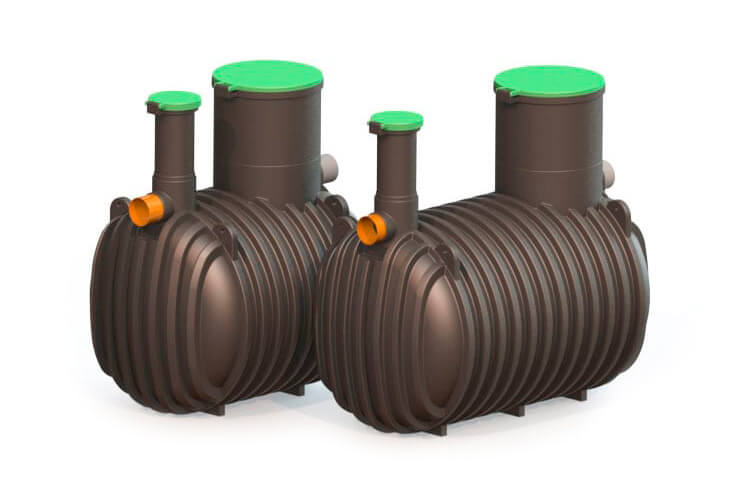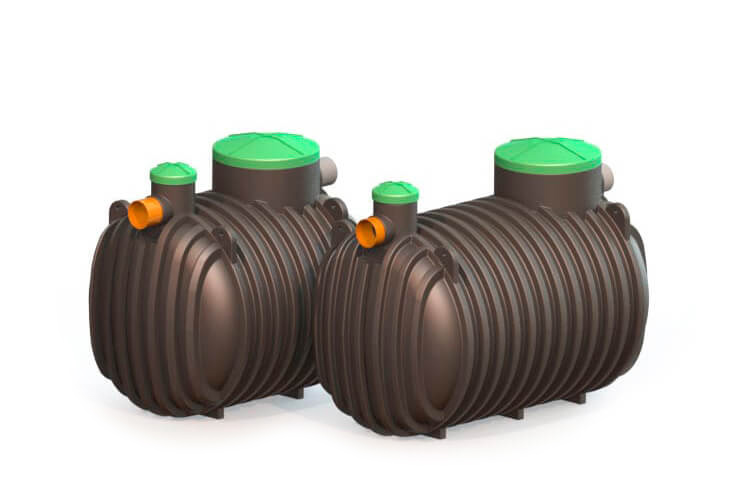SBR biological treatment plant
The SBR biological treatment plant is designed to treat domestic and municipal sewage, where efficient treatment under variable load is required.
The biological treatment plant, due to its specific design, is resistant to excess sewage, overloading, temperature fluctuations and temporary lack of sewage inflow, e.g. due to holiday trips. Thus, typical applications of the SBR treatment plant also include small settlement units, recreation and sport centres, hotels and tourist resorts.
The technology of sewage treatment with active sludge in batch systems is based on sequencing batch reactors (SBR). The treatment process is cyclic and consists of several phases.
Sewage treatment phases in the biological treatment plant:
- Preliminary phase – Completion of the decanting process of the layer of clarified, treated sewage. Raw sewage flows into the reactor.
- Mixing and filling phase – Raw sewage still flows into the reactor, in which aerobic and anaerobic conditions are produced alternately. Active sludge pressure increases with the sewage inflow. Due to the control of aeration unit operation, the nitrification and de-nitrification processes run simultaneously.
- Final phase – Completion of the technological processes related to the treatment; sewage level in the tank is approaching the maximum.
- Sedimentation phase – Stop of the aeration and mixing unit operation. The process of sludge sedimentation and sewage clarification begins.
- Decanting and excess sludge removal phase – After the sedimentation process, active sludge gathers in the bottom layer, thus revealing a layer of clarified sewage. Pump-based or static decanting of treated sewage follows. After the process is completed, excess sludge is removed.
The standard type series of the treatment plant available is designed for 2 to 12 inhabitants. After the biological treatment plant is fitted with additional components, the plant can support systems above 12 inhabitants. On-site sewage treatment plants according to the Wikipedia.
Subsidy for sewage treatment plants
The construction of an on-site sewage treatment plant can be subsidised. For more information, see the website of the Polish National Fund of Environmental Protection and Water Management.
Our range includes all kinds of tank top extensions, expansion telescopes, covers, distribution wells, control units, drainage pipes, infiltration tunnels and filters for treatment plants.
Specifications
Technical description
Table of available size configurations of SBR biological sewage treatment plants.
Model, capacity, population equivalent, daily amount of sewage (m3/day):
- EKO SBR 2-4 | 2500 litres | 2-4 | 0.3-0.6
- EKO SBR 4-6 | 3500 litres | 4-6 | 0.6-0.9
- EKO SBR 6-8 | 4750 litres | 6-8 | 0.9-1.2
- EKO SBR 8-10 | 6750 litres | 8-10 | 1.2-1.5
- EKO SBR 10-12 | 8000 litres | 10-12 | 1.5-1.8
Advantages
- Safe plant design has been achieved by eliminating moving parts,
- The SBR biological treatment plant bears a CE mark – It was tested by a notified testing body for compliance with PN-EN 12566-3 +A1:2009,
- Low vulnerability to power outages,
- The treatment process is automated – ability to control the whole treatment cycle. In addition, the control is automatically adjusted to the sewage inflow,
- The option to set the treatment plant to standby mode – possible to maintain the treatment process even with no sewage inflow for up to 2 weeks,
- The treatment in the SBR biological sewage treatment plant is achieved with no need for biological preparation use,
- Long period of use and reliability – PE tanks are made monolithic and additionally strengthened with steel reinforcement inside the tank.
Environmental protection
- The SBR biological treatment plant tanks and their internal components are 100% recyclable and the raw material is re-usable,
- The equipment is energy-efficient – it both saves money and protects the environment,
- By treating sewage, we protect the precious resource – water.
Applications
- Single- and multi-family houses,
- Resorts,
- Small enterprises,
- Camp sites,
- Tent sites, etc.


